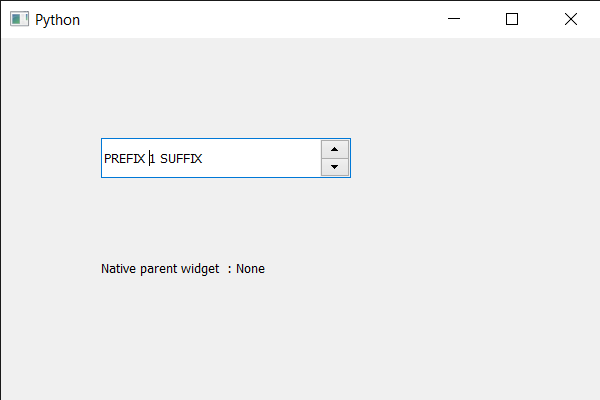En este artículo veremos cómo podemos obtener el widget principal nativo del cuadro de número. El widget padre nativo es el siguiente widget antepasado que tiene un identificador de sistema o un valor nulo si no tiene ningún padre nativo.
Para hacer esto, usamos nativeParentWidgetel método con el objeto de cuadro de número.
Sintaxis: spin_box.nativeParentWidget()
Argumento: no requiere argumento
Retorno: devuelve el objeto QWidget pero si no hay un padre, devuelve Nulo
A continuación se muestra la implementación.
# importing libraries
from PyQt5.QtWidgets import *
from PyQt5 import QtCore, QtGui
from PyQt5.QtGui import *
from PyQt5.QtCore import *
import sys
class Window(QMainWindow):
def __init__(self):
super().__init__()
# setting title
self.setWindowTitle("Python ")
# setting geometry
self.setGeometry(100, 100, 600, 400)
# calling method
self.UiComponents()
# showing all the widgets
self.show()
# method for widgets
def UiComponents(self):
# creating spin box
self.spin = QSpinBox(self)
# setting geometry to spin box
self.spin.setGeometry(100, 100, 250, 40)
# setting range to the spin box
self.spin.setRange(1, 999999)
# setting prefix to spin
self.spin.setPrefix("PREFIX ")
# setting suffix to spin
self.spin.setSuffix(" SUFFIX")
# creating a label
label = QLabel(self)
# making the label multi line
label.setWordWrap(True)
# setting geometry to the label
label.setGeometry(100, 200, 200, 60)
# getting native parent widget
value = self.spin.nativeParentWidget()
# setting text to the label
label.setText("Native parent widget : " + str(value))
# create pyqt5 app
App = QApplication(sys.argv)
# create the instance of our Window
window = Window()
# start the app
sys.exit(App.exec())
Producción :
Publicación traducida automáticamente
Artículo escrito por rakshitarora y traducido por Barcelona Geeks. The original can be accessed here. Licence: CCBY-SA